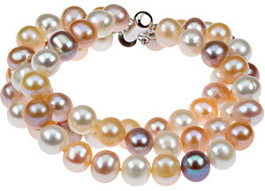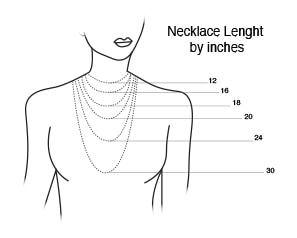FREE ALLUREZ TRAVEL CASE WITH PURCHASE OF $500 OR MORE
ENDS IN:
00
Days
00
Hrs
00
Min
00
Sec
VIEW MORE
MENU
CURRENCY

Unlike gemstones which come from the earth itself, pearls are made by living things called mollusks, such as oysters. Oysters, when irritated by a foreign substance gradually release a natural substance known as nacre. It is the buildup of this light reflecting nacre that eventually forms a natural or cultured pearl and helps give it its luster and color.
Pearls are not perfect; in fact, it is their imperfections that make them unique. Since the creation of a pearl has a lot to do with nature, even when they are farmed, imperfections are the rule, not the exception. Uneven layers of nacre secretion create irregularities both below and on the surface of the pearl. It is this rough exterior, that when rubbed against ones teeth, clearly helps it stand out from smooth, artificial pearls.
Allurez’s pearl selection is carefully chosen to provide the best quality cultured pearl jewelry available. Every pearl meets our own high standards, providing a promise of quality, durability and long-lasting pleasure.
Nature vs. Nurture
Both cultured and natural pearls are created using a similar process, with the primary difference stemming from how the irritant finds its way into the oyster. Natural pearls develop from completely natural resources and are free to develop without human intervention. Cultured pearls are nurtured by pearl farmers who insert irritants and continually monitor the environment in which the oysters develop and grow.
A cultured pearl is not a fake; the nacre created during the culturing process is completely natural and the resulting pearls are beautiful and highly prized. These pearls receive a helping hand from farmers in the initial culturing process, and a lot of nurturing along the way, while a natural pearl is created through 100% natural channels. Through the years natural pearl development has been hampered by pollution and environmental challenges making them rare and extremely expensive. Now, even the most expensive pearls are cultured pearls.

Choosing the right pearl for you is a personal decision. There are however some basics that you might want to follow when choosing the best pearls for you. First choose the color that will work well with your hair color and skin tone’:
| Blonde Hair Color | White/Rose Colors |
| Brunette Hair Color | Cream/Rose Colors |
| Pinkish Skin Tones | Cream/Rose Colors |
| Light Skin Tones | Pink, White/Rose, Light Cream/Rose |
| Reddish Hair Color | Cream/Rose Colors |
| Choker | 14” – 16” |
| Princess | 16” – 19” |
| Matinee | 10” – 24” |
| Opera | 30” – 36” |

Bib: This type of necklace consists of several pearl strands of varying lengths.
Collar: These are worn high on the neck and consist of multiple strands of pearls that are normally 12-13 inches long. Collar necklaces were extremely popular during the Victorian era.
Choker: Similar to a collar style pearl necklace, a choker is worn a bit lower on the neck at 14-16 inches long.
Princess: This is considered the classic length for pearl necklaces, lying slightly below the neck. This type of necklace is 17-19 inches long.
Matinee: A more semi-formal or formal situation usually brings out the Matinee style necklace which is approximately 20-24 inches long.
Opera: This particular pearl necklace style falls below the bust line and is perfect for formal occasions. For daytime wear many either knot it or double it. The opera necklace is 30-36 inches long.
Pearls have a rich and beautiful history. During the multiple centuries that pearls have been revered, their colors have taken on various historic meanings including:
| Peacock Green: | Symbol of Romance |
| Rose, Pink: | Symbol of Love |
| White: | Symbol of Purity |
| Sapphire Blue: | Symbol of Eternity |
| Golden: | Symbol of Wealth |
| Black: | Symbol of Dignity |